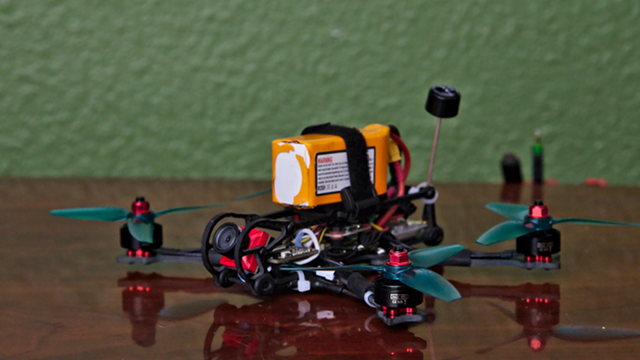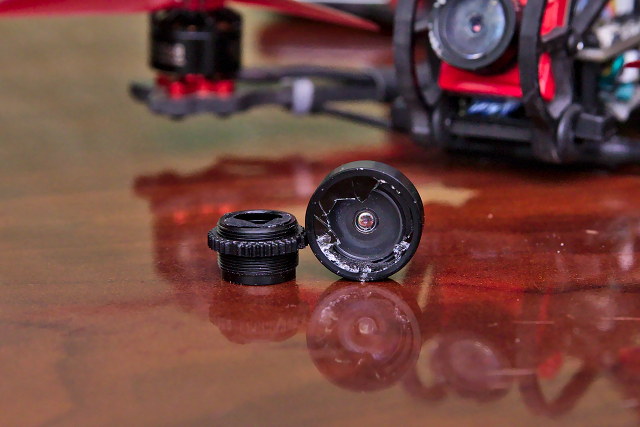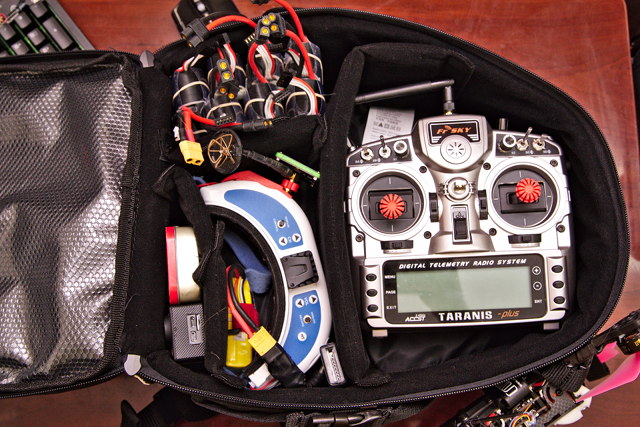I’m not sure how accurate the title of this blog post is. I’ve been working on my Kestrel HD micro FPV frames for several months. I’ve probably been flying it with a Caddx Turtle V2 for something closer to a month and a half, but that would make for a convoluted title, hayna?
I’ve been carrying a 2.5” or 3” micro FPV drone in my bag for two years, but the Kestrel is my first micro capable of capturing HD footage. I’ve avoided these kinds of builds for a long time, but the components for micros are getting better, and the FPV cameras that double as HD recording cameras have improved quite a bit, too.
Going into this, I had some ideas of how my 3” micro and lightweight 4” builds would compare to my heavy 5” freestyle. I think I’ve been messing around with the micros long enough to have some useful data and opinions about my experiences at this point.
HD micros should be more durable
For the most part, I still think this is true. My 680-gram 5” freestyle quad has so much more inertia than my 225-gram 3” Kestrel or my 270-gram 4” Kestrel.
Sure, the smaller motors are built with smaller bearings and thinner material, but you won’t be subjecting them to as much stress in an impact. It ought to be harder to smash motors.

The micro frames are thinner and lighter. I thought for certain that my Kestrel’s arms would break by now. I made them just about as narrow as I thought I could get away with. I assumed they’d need to be one or two millimeters wider, but they’re holding up quite well!
It is unfortunate that the Caddx Turtle has been rather fragile. I killed my first Turtle when I got stuck in a tree. Very, very high up in a tree! I had to do a lot of gymnastics in both turtle mode and air mode to wiggle the quad free, and I had to wiggle free several times, because I kept getting stuck on more branches on the way down!
The Caddx Turtle must have taken a voltage spike or something while I was jamming on the throttle trying to break free. It stopped recording while I was still in the tree, and it hasn’t worked since.
Today, I smashed a lens and an ND filter. My Caddx ND filters arrived today, and I just had to try them out. The winds were up over 15 MPH today, so I didn’t expect to get great footage, but I wanted to try them out.

After flying a battery on my 4” Kestrel, I swapped the filter over my 3” Kestrel. As soon as I gave it a bit of throttle, it tried to shoot up to the moon, so I had to disarm. It landed upside-down on concrete. The ND filter was smashed, and the plastic lens was snapped in two.
In my first month or two, I’ve burned through a $65 camera, a $7 ND filter, and a $10 lens. These aren’t expensive components, but I’ve been flying with a GoPro HERO5 Session on my big, heavy quad for more than a year, and I’ve only destroyed one GoPro. I’m not excited about this trend so far.
At least today, it was only the lens that broke. If the threaded shaft of the Caddx lens were made of metal, I probably would have smashed the camera’s housing or sensor!
HD micro quads are safer
This mostly comes back to weight again. I’ve had my 680-gram 5” freestyle quad up over 120 MPH. I don’t get up to speeds like that very often, but can you imagine what would happen if I hit something? It would be like shooting a frozen turkey at a high-speed train.
Even if I just have to disarm my big quad while it is 200 feet in the air, whatever is underneath is going to have a bad time—hopefully it is just grass or pavement! This is why we’re so careful about when and where we fly.
My 3” Kestrel is a rather light build. It comes in at about 225 grams with a 650 mAh 4S battery. With that battery, it has enough juice for about five minutes of fairly aggressive freestyle flying. It weighs about 1/3 as much as my big, scary quad, and it can’t hit 120 MPH.
It is a bit like the difference between a basketball and a dodgeball. If I throw a basketball at your face as hard as I can, I might break your nose. If I do the same with a dodgeball, you’re going to be unhappy, but you’ll be fine.
I’m not saying you can just start flying your micro quad near people. Those props will still cut someone quite badly, and it is still heavy enough to hurt someone!
HD micros cost less than a full-size miniquad
My 3” Kestrel build costs around $250. My 5” freestyle quads cost more than twice as much, and I have to strap a $200 to $300 GoPro on top of those quads. I think it is awesome that it is possible to capture decent HD footage for the price of a GoPro.
Is it really cheaper, though? I can strap a $100 refurbished GoPro HERO4 Session to a $130 bind-n-fly 5” quad, and I know that I’ll get better footage. That aging GoPro is so much better than a Caddx Turtle. The Caddx Turtle or Runcam Split need the equivalent of GoPro’s SuperView!
At the rate that I’ve been breaking Turtles, I’m worried that this is going to get expensive. Time will tell.
Don’t forget about batteries. The 650 mAh 4S packs I use on my micros cost half as much as the 1,000 mAh 6S packs I use on my 5” quads, and my micros tend to fly a little longer on each pack.
5” freestyle quads fly better than 3” micros
Due to a combination of Earth’s gravity, air density, and the scale of human construction, 5” miniquads are the sweet spot for FPV freestyle. They’re heavy enough that 10 or 15 MPH winds don’t shake them around. They’re light enough that they can accelerate quickly, and their props are the right size and weight to make them agile.
You just can’t huck a 250-gram micro quad over an obstacle. I can punch the throttle on my 5” freestyle quad for a second or two, cut the throttle, and flip upside down. My momentum will easily carry me over a tree.
The 250-gram 3” quad doesn’t have the momentum or inertia for that. The air is thick enough to slow it down. If I attempt the same thing with my 3” or 4” Kestrel, I will most likely not make it over the tree!
Be brave, @patsheadcom. And don't hit a ghost branch!
— Pat Regan (@patsheadcom) December 28, 2018
I did come close to a ghost branch. pic.twitter.com/bkBIgWV4ze
This isn’t just a problem for micros. 5” racing setups without GoPros don’t have the same problem. They’re built lighter than freestyle drones to begin with, and they’re also not carrying a 110-gram GoPro. The 5” racer will carry farther than the 3”, but not as much as my heavy 5” freestyle build.
No matter how hard I try, I just can’t tune in my rates to make my 3” feel like my 5”. I’m sure some of that is in my head, and if I flew the 3” exclusively for a long time, I would adjust.
3” and 4” micros are lighter
Weight can be a blessing and a curse. We already talked about the light weight of a 3” micro making it safer than my beefy 5” quads. Micros are also easier to carry.
They take up less space, their batteries weigh less, and in my case, each battery lasts a little longer!
My huge ThinkTank backpack weighs about 27 pounds when fully loaded. That’s with three 5” quads, a 3” quad, plenty of batteries for each of those quads, all sorts of tools, a LiPo charger, a big field-charging battery, and a comfy 2-pound chair. I usually only take this bag when I’m driving.

When I’m riding my electric bike, I take my AmazonBasics DSLR backpack. With one 5” quad, six batteries, and a chair, it weighs about 12 pounds. That setup will keep me flying for almost 24 minutes.
If I pack both my 3” and 4” Kestrel, I can carry 45 minutes’ worth of battery. Not only that, but I can squeeze those two quads and all that battery in under 10 pounds. It isn’t a huge savings in weight, but any weight savings is nice when you’re walking, and the extra 20 minutes of flight time is awesome!
A $100 GoPro beats a $65 Caddx Turtle V2
These two cameras are barely comparable. I’m disappointed in almost every minute of footage I’ve captured so far with my Caddx Turtle.
The field of view on the Turtle seems narrow, and I miss SuperView. You can’t set the Turtle to 30 frames per second, because you’ll be stuck with that slow frame rate in your FPV feed. You absolutely have to use an ND filter to push the shutter speed high enough to get acceptable footage out of the Turtle.
I would get much better footage with my old $120 BFight 210 with a refurbished, outdated, $100 GoPro Session.
Even with the ND filter, the Turtle seems to dislike my style of flying. Slow, cinematic footage looks alright. Quick moves look sloppy compared to the footage from a GoPro.
That said, though, I feel like I’m actually getting some usable footage out of the Caddx Turtle now that I’m flying with an ND16 filter!
I don’t understand why you’re flying a freestyle micro quad!
As I’ve been going through the pros and cons here, I’ve noticed that I’m listing a lot more cons than pros, right? Some of those cons are huge, too. The cheapest, oldest GoPro Session is drastically better than a Caddx Turtle. That seems like a good enough reason to skip HD micros all together.
Even considering all these cons against the pros, I’m still excited about having an HD micro quad in my bag, and I’m having a lot of fun designing a frame! Being able to carry nearly an hour of fun in a bag that weighs less than 10 pounds is awesome. I don’t always need to be capturing the best possible HD footage, do I? It is OK to just go out to have fun!
By the time I saw that single, thin ghost branch in my goggles, it was way too late to avoid it. Visibility in my goggles was poor down there in general, and my thumbs were getting shaky. Don't explore a narrow creek on your first battery on an empty stomach! pic.twitter.com/8JF2910jqZ
— Pat Regan (@patsheadcom) March 26, 2019
That’s what I was already doing with my Leader 3 micro. Adding an HD camera to that kind of setup isn’t expensive, and it is nice to have access to that footage, even if it isn’t the best.
If all I needed was a hold-my-beer quad, my old BFight 210 with a cheap GoPro would work great. My Kestrels can handle that job, but they’re also useful in situations where a 5” quad like the BFight 210 would be too loud or feel too dangerous.
Conclusion
I like HD micro quads. They’re inexpensive. They fly almost as well as a 5” freestyle quad, assuming you don’t need the extra momentum. The HD cameras are almost good enough.
The situation will only get better. Cameras are getting better. Frames are getting better. Flight controllers, 4-in-1 ESC boards, and motors are getting better. Props are getting better. Literally everything related to micro quads is improving!
3” micros are a great way to get into FPV. They are cheaper and safer than their 5” cousins, and it doesn’t cost much to add reasonable HD video recording to your build. If you want to get into FPV freestyle, and you want to record decent HD video, spending $250 or so on a build like my Kestrel with a Caddx Turtle would seem like a pretty good plan!
What do you think? Is your experience with HD micros similar to mine? Do you think I’m going to have the same thoughts, opinions, and experiences over the next six months? Let me know in the comments, or stop by our Discord server to chat about it!